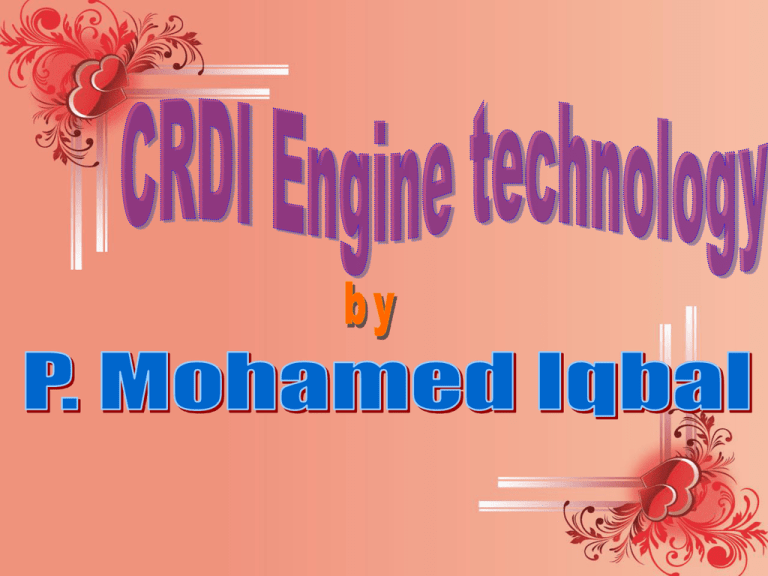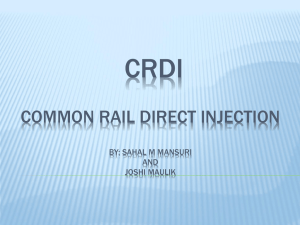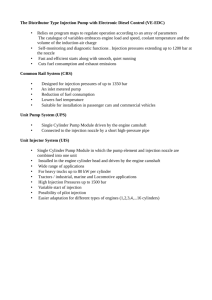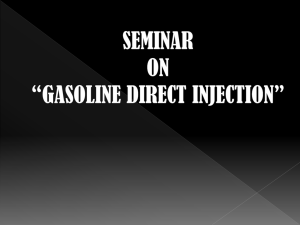The Common Rail Sub functions
advertisement

Overview Introduction Principle Working Features Scope for further development Conclusion Introduction The country among other things has seen an enormous development in engines used in cars also. The Diesel engines have also undergone a sea change from the time Rudolf Diesel invented it way back in 1892. Today Common Rail Direct Injection (CRDI) is the order of the day. CRDI Engine Principle Unlike in conventional diesel engines, the fuel is fed into the common tube or rail and high pressure is maintained. This allows fuel to combine with air much more efficiently. It features high-pressure fuel rail feeding individual solenoid valves as opposed to low-pressure fuel pump feeding injectors. Layout of a CRDI Engine The Common Rail Sub functions Low –pressure circuit comprises of: Fuel tank ,Pre-supply pump, Fuel filter, And the respective connection lines. Low –pressure circuit The low –pressure circuit is responsible for transporting the fuel to the high –pressure circuit The Common Rail Sub functions High –pressure circuit comprises: High – pressure pump with pressure – control valve The high – pressure accumulator (Rail )with the rail –pressure sensor Injectors, and The respective high – pressure connection lines. The high – pressure circuit It is the responsibility of the high pressure circuit to generate a constant unvarying high pressure in the high pressure accumulator (the rail) and to inject the fuel through the injectors into the engine’s combustion chambers. The Common Rail Sub functions ECU and sensors The common rail ECU evaluates the signals from the following sensors. Crankshaft – speed sensor, Camshaft sensor, Accelerator-pedal travel sensor The Common Rail Sub functions The common rail ECU evaluates the signals from the following sensors: Boost – pressure sensor, Air temperature sensor, Air – mass meter, and Rail pressure sensor. The Common Rail Sub functions ECU and sensors The sensor are responsible for measuring important physical quantities. The ECU calculates injected fuel quantity, start of injection, duration of injection, and rate of discharge curve, as well supervises the correct functioning of the injection system as a whole. COMMON RAIL FUEL INJECTION SYSTEM DESIGN PRE SUPPLY PUMP Transports fuel from the fuel tank to the high pressure pump. An electric fuel pump is used for this purpose in the CRFIS. When the electric fuel pump is switched off, the supply of fuel is interrupted and the engine stops. PRE SUPPLY PUMP The electric fuel pump comprises of: 1.Electric Motor 2.Roller-Cell Pump 3.Non Return Valve PRE SUPPLY PUMP The roller cell is driven by an electric motor. Its rotor is mounted eccentrically and provided with slots in which movable rollers are free to PRE SUPPLY PUMP The rollers are forced against the base plate by rotation and by fuel pressure . The fuel is transported to the outlet openings on the pump’s PRE SUPPLY PUMP variants Gear type fuel pump The drive gear wheel is driven by the engine . Delivery quantity is directly proportional to engine speed . Shut off is by means of an electromagnet.. High- pressure pump The pump plunger moves downwards The inlet valve opens The fuel is drawn in to the pumping element chamber(suction stroke) High- pressure pump At BDC, the inlet valve closes The fuel in the chamber can be compressed by the upward moving plunger. High- pressure pump An electromagnet is used for pumping element switch-off. High- pressure accumulator (Rail) Store fuel Prevent pressure fluctuations High- pressure accumulator (Rail) Rail is a forged-steel tube. ID is approx.. 10mm Length is between 280 and 600mm The volume must be “ as small as possible, as large as necessary” Pressure-control valve (DRV) Responsible for maintaining the pressure in the rail at a constant level. Rail-pressure sensor (RDS) Measures the pressure in the rail inputs the information to the ECU RDS should provide extremely precise measured values. RDS is mounted directly on the rail. Injector Injects exactly the correct amount of fuel in to the combustion chamber at precisely the right moment in time Injector The injector is equipped with: 2/2 electromagnetic servo valve Nozzle Valve control chamber Return line Injector The essential forces for correct functioning are: Nozzle-spring force Valve spring force Electromagnet force Force due to the pressure in the valvecontrol chamber Force due to the pressure in the nozzle needle ECU with sensors Common Rail is an EDC controlled injection system The ECU controls & monitors the complete injection process The sensors delivers all the measured values which are required in the process COMMON RAIL FUEL INJECTION SYSTEM Summary Components of CRFIS are: Pre-supply pump High-pressure pump High-pressure accumulator(rail) Pressure-control valve Rail-pressure sensor Injectors ECU with sensors Working Solenoid valves make possible fine electronic control over the injection time and amount, and the higher pressure that the common rail technology makes available provides better fuel atomization. In order to lower engine noise, the engine's electronic control unit can inject a small amount of diesel just before the main injection event ("pilot" injection), thus reducing its explosiveness and vibration, as well as optimizing injection timing and the process continues Features Direct injector Spiral-shaped intake port Integrated port Air flow metering Multiple Pilot injection and Post injection Powerful Microcomputer Newly-developed catalytic converters Reduced noise levels Direct injector A fuel injector is nothing but an electronically controlled valve. Spiral-shaped Intake port Provides optimum swirl and even distribution of fuel. Integrated port Integrated port is used for exhaust gas recycling. There are three advantages to this system • eliminates external pipes which are subject to vibration • quicker engine warm-up • better combustion. Air flow metering It gives exact analysis of the air-mass that is being taken in. Due to this metering system, the microcomputer that controls engine timing receives precise data. Multiple Pilot injection and Post injection Pilot injections is small doses of fuel made prior to the main injection which help to smoothen the sharp combustion character. Post injection is a similarly small dose of fuel injected after the main injection to reduce particulates. Powerful Microcomputer The microcomputer regulates the amount of time the valves stay open and thus the amount of fuel injected, depending on operating conditions and how much output is needed. Newly-developed catalytic converters Besides electronically-controlled exhaust-gas recycling which contributes to lower nitrous oxide emissions, CRDI engines are equipped with catalytic converters near the motor and emission control devices on the underbody. These vouch for a high degree of efficiency. Reduced Noise levels The Electronic control and multiple injections reduced noise to a great extent Scope for further development Use of different fuels for zero emissions and better engine performance By using different fuels and cetane improvers, maximum torque can be obtained Lowering the cost Closed-loop control injection with ion sensing technology Conclusion CRDI technology revolutionized diesel engines. It has changed the way one looks as diesel cars by providing the above said advantages. Advantages -More power is developed -Increased fuel efficiency -More stability -Pollutants are reduced -Particulates of exhaust are reduced -Exhaust gas recirculation is enhanced -Precise injection timing is obtained -Pilot and post injection increase the combustion quality -The powerful microcomputer makes the whole system more perfect Manufacturers of CRDI engine The car makers refer to their common rail engines by their own brand names. Some of them are BMW's D-engines Mahindra's CRDe Tata's DICOR Honda's i-CTDi Hyundai-Kia's CRDi etc References International Journal of Automotive Technology Approaches to Automotive Emissions Control Magazines: Auto week, Automobile India






